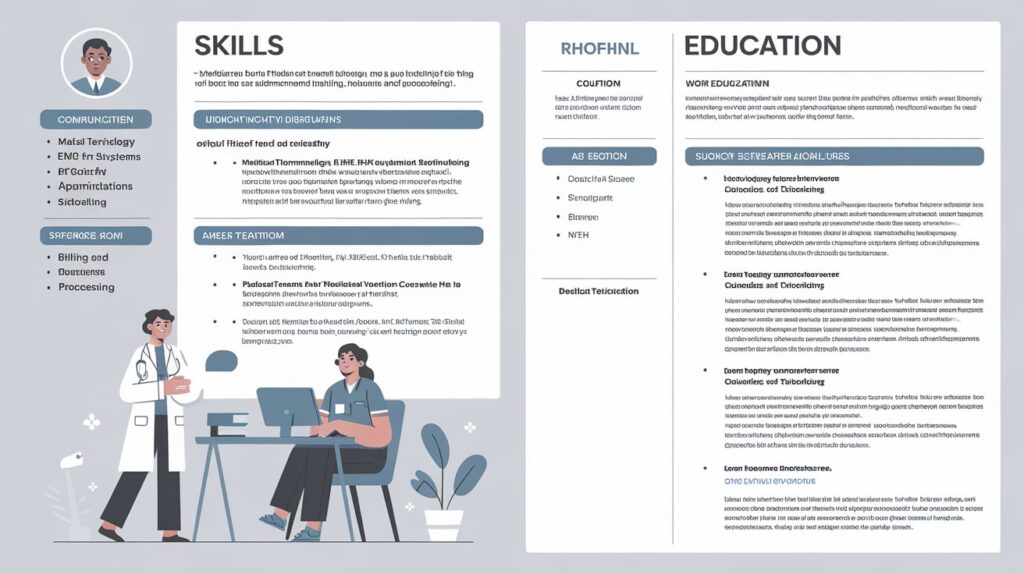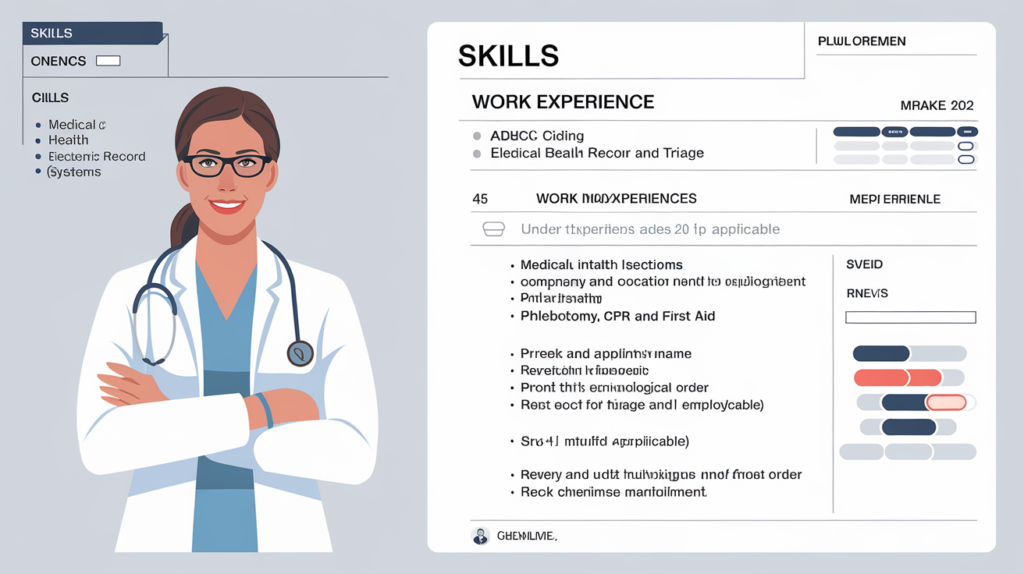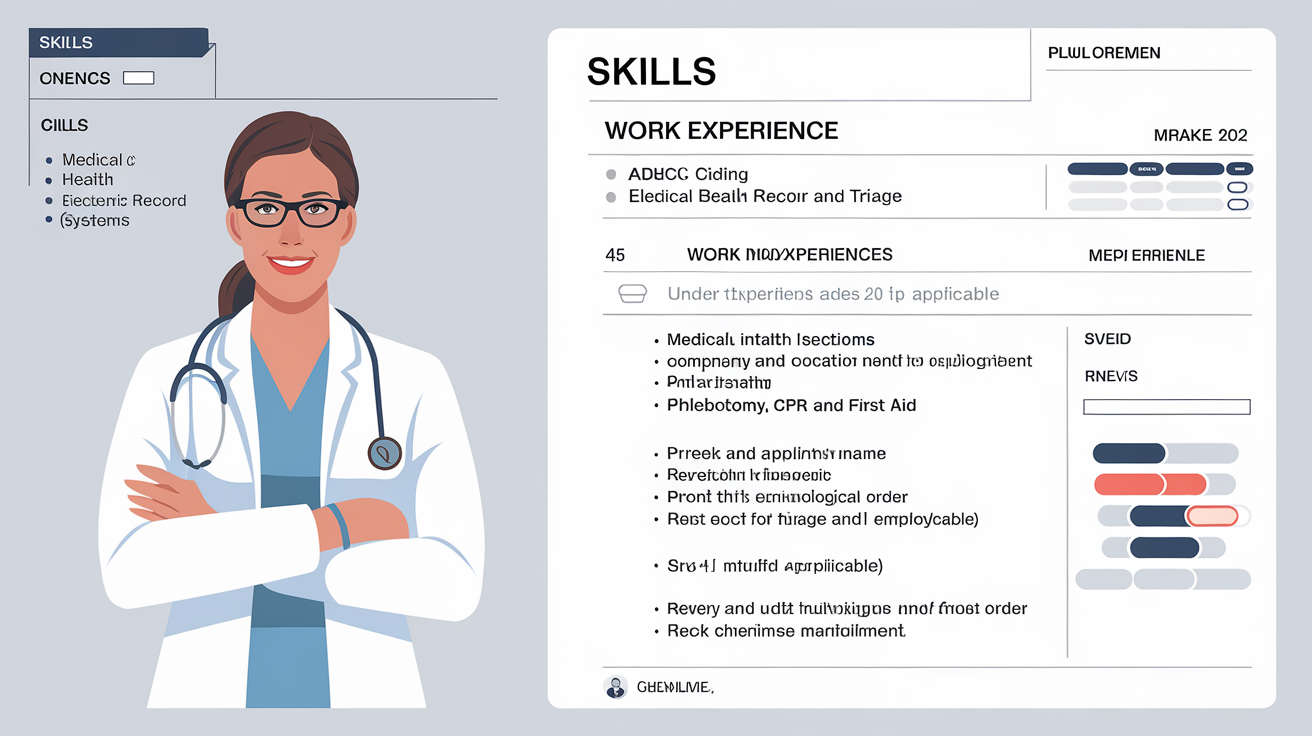In today’s competitive job market, a well-crafted medical assistant resume is essential to stand out. Whether you are an experienced medical assistant or just entering the healthcare field, a resume that highlights your skills, qualifications, and experience is crucial to securing an interview. This comprehensive guide will walk you through the key components of a successful medical assistant resume, offer tips for optimizing it for both human eyes and applicant tracking systems (ATS), and show you how to increase your chances of landing the perfect medical assistant job.
Table of Contents
What is a Medical Assistant Resume?
A medical assistant resume is a professional document that showcases your education, experience, and qualifications specific to the medical assisting field. It is designed to help hiring managers quickly assess your capabilities and decide whether you’re the right fit for a healthcare facility. Your resume should reflect your expertise in administrative tasks, clinical duties, and patient care, all of which are essential for a medical assistant role.
Key Elements of a Strong Medical Assistant Resume
- Contact Information
Begin your medical assistant resume by listing your full name, phone number, email address, and location. You don’t need to include your full address—your city and state are sufficient. - Resume Summary or Objective
Your resume summary should provide a quick snapshot of your experience and skills. For example:
- “Certified medical assistant with 5 years of experience in administrative and clinical roles, proficient in patient care, medical record management, and EHR systems.”
Alternatively, if you are new to the field, a resume objective would be more appropriate. For example: - “Recent graduate with a diploma in medical assisting, seeking to apply skills in patient care and administrative support at a reputable clinic.”
- Skills Section
A medical assistant resume should include a skills section that highlights your core competencies. Focus on both hard and soft skills relevant to medical assisting. Some important skills for a medical assistant resume are:
- Patient care
- EHR (Electronic Health Records) management
- Scheduling and appointment management
- Clinical procedures (phlebotomy, EKG, etc.)
- HIPAA compliance
- Multitasking and time management
- Communication skills
- Medical billing and coding
- Work Experience
In the work experience section, list your previous positions, starting with your most recent job. Each entry should include:
- Job title
- Name of the healthcare facility
- Dates of employment
- Responsibilities and achievements (use bullet points) For example:
Medical Assistant | ABC Medical Clinic
July 2019 – Present - Assisted doctors and nurses with clinical procedures, including blood draws and EKGs.
- Managed patient intake, scheduled appointments, and handled insurance claims.
- Maintained accurate patient records using EHR software.
- Delivered patient education on post-procedure care and medications.

Tailoring Your Resume for a Medical Assistant Job
When applying for a medical assistant position, it’s essential to tailor your resume to the specific job description. Customizing your resume increases your chances of getting noticed by both the hiring manager and the ATS. Here’s how to tailor your medical assistant resume effectively:
1. Use Job-Specific Keywords
Many healthcare employers use applicant tracking systems to scan resumes for relevant keywords. If your resume lacks the necessary keywords, it may never reach a human recruiter. Review the job posting carefully and incorporate job-specific keywords such as:
- Certified Medical Assistant (CMA)
- Patient care
- HIPAA compliance
- Medical coding and billing
- Phlebotomy
- EHR systems
- Clinical support
2. Emphasize Relevant Experience
If you’ve held medical assistant positions in the past, focus on clinical and administrative experience that aligns with the job you’re applying for. Highlight relevant duties like taking patient vital signs, assisting with minor surgeries, or managing medical records.
3. Showcase Your Certifications
Certifications are a critical part of any medical assistant resume. If you have a certification like the Certified Medical Assistant (CMA) or Registered Medical Assistant (RMA), make sure it is prominently displayed in the education or skills section. Including certifications adds credibility and shows you’ve met industry standards.
Writing Tips for an ATS-Friendly Medical Assistant Resume
Most employers in the healthcare industry use ATS software to filter through resumes before they even reach a hiring manager. To improve your chances of getting through the ATS and into the interview stage, follow these tips:
- Use Simple Formatting
ATS software may have difficulty reading complex designs, charts, and images. Stick to a clean, simple resume format with clearly defined sections and bullet points for easy readability. - Include Relevant Keywords
As mentioned earlier, the keywords on your medical assistant resume should match those in the job posting. Use terms like “patient care,” “medical records,” “clinical procedures,” and “HIPAA” to ensure your resume passes the ATS scan. - Avoid Overuse of Abbreviations
While abbreviations like “CMA” or “EKG” are common in the healthcare field, the ATS might not always recognize them. Always spell out the full term at least once (e.g., “Certified Medical Assistant (CMA)”) to ensure the software identifies the keyword correctly.
Additional Sections to Consider
Including optional sections can further enhance your medical assistant resume. Here are a few you might consider:
1. Certifications and Licenses
If you hold any additional certifications beyond your medical assistant certification (such as Basic Life Support or CPR), list them in a separate section to highlight your qualifications.
2. Education
In the education section, list any formal medical training you’ve received. If you have a diploma or associate degree in medical assisting, include the institution, dates attended, and any honors received.
3. Volunteer Work
If you have volunteer experience related to healthcare, include it. This can be especially useful if you are a new graduate or transitioning to the medical assistant role.
Action Words for a Medical Assistant Resume
Strong action verbs can make your medical assistant resume more compelling. Use dynamic language to describe your responsibilities and achievements. Here are a few examples:
- Assisted
- Administered
- Managed
- Coordinated
- Documented
- Educated
- Scheduled
- Prepared
- Communicated
- Monitored

Sample Medical Assistant Resume
Here’s a quick example of a medical assistant resume:
Jane Doe
(123) 456-7890 | [email protected] | City, State
Professional Summary
Certified Medical Assistant with 4+ years of experience in providing administrative and clinical support in busy healthcare settings. Proficient in patient care, appointment scheduling, and EHR systems. Passionate about delivering excellent patient care and ensuring efficient clinic operations.
Skills
- Patient care
- HIPAA compliance
- Medical billing and coding
- Clinical procedures
- EHR management
- Time management
Experience
Medical Assistant
XYZ Family Clinic, City, State
June 2020 – Present
- Conducted patient intake, including recording vital signs and medical history.
- Assisted healthcare professionals in clinical procedures like administering injections and drawing blood.
- Managed patient scheduling and appointment follow-ups.
Education
Medical Assisting Diploma
City College, City, State
Graduated: 2020
Certifications
Certified Medical Assistant (CMA)
CPR Certification
Conclusion
A well-written medical assistant resume is your ticket to landing the job you want. By focusing on your skills, experience, and certifications, and optimizing your resume for both ATS and human readers, you can make sure your application stands out. Follow this guide to create a strong, tailored medical assistant resume that highlights your strengths and helps you move forward in your healthcare career.

